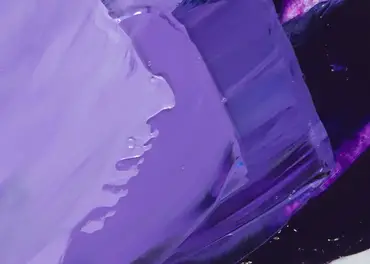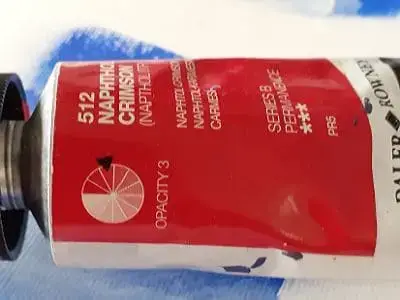Last Updated on March 15, 2024 by Masha Eretnova
Do you feel like you need to make your acrylic paint more opaque?
You are probably most annoyed with your yellow… The problem gets worse as some acrylic may dry darker and what visible when wet is now gone…
Some pigments are naturally more opaque like white, black, grey, and brown, while some are naturally translucent like yellow, some reds and light greens, but we can still make them brighter and more opaque.
To make acrylics more opaque mix paint with gesso, mix your color with a small amount of Titanium white, or even apply a coat of white or carbon black underneath to make acrylics seem more opaque.
Opacity is still a tool to correct mistakes and shape objects. The opaque color seems brighter and thicker. I love opacity and will share with you 7 easy ways to make your acrylics more opaque, but also we will see what 8 brands and colors are actually more opaque than others.

This article contains affiliate links. It means no extra cost for you but a little commission (2-3%) for me to support my hobby and blog. Thank you!
Table of Contents
7 Ways to make acrylics more opaque
I will start directly with my methods but I highly recommend you to read first the paragraphs about why acrylics are opaque, how to read labels and what pigments are more opaque to be more confident and even start thinking of some own ways to make acrylics more opaque.
I’m mostly creating abstract paintings and using only opaque pigments such as white, black, and red. But when I’m creating clouds, sky, beach, and other beautiful pictures that surround me, to make my acrylic paint more opaque, I use these methods:
A quick note on opacity: acrylic is truly one of the most opaque paints by nature. Other water-based paints that are opaque but matte are gouache, tempera, and poster paints. Watercolor is not opaque. Oil paints are as opaque and shiny as acrylics.
Too opaque? Try this: 11 Proven Ways How to Make Acrylic Paint Transparent That Pros Use
1 – Add Titanium White or Carbon Black
Titanium White is the most opaque color. The easiest way to make acrylics more opaque is to mix acrylic paint with a small amount of

Adding white color can be an easy way, but it is also a tricky one. By adding white we will create more pastel colors as white paint tints other colors.
Try to add only a small amount and test the color before painting or using the color chart wheel.

You can also paint one good coat of white or black paint before applying the main colors. It will make colors brighter. In fact, it doesn’t affect the opacity of the color but it will create the illusion of opacity as it stops the color underneath from influencing it.
When you decide to paint over a dark color, the paint will simply disappear without an additional layer of white.
How To Mix Acrylic Paint? – Your Complete Color Mixing Guide

How to apply a layer of
- Make sure your previous layer of paint is dry.
- Paint another layer of
titanium white only where you want to put your transparent color. Let the white dry. Apply black to increase the opacity of semi-opaque colors. - Paint your color over white or black.
If you apply white or black as the first layer, wait until it’s dried!
2 – Use gesso – my favorite method
Gesso is necessary for the best surface priming. There are 2 options for how you can make acrylics more opaque with gesso:
- Apply 3-4 coats of gesso before painting. The gesso should prepare your canvas for painting, it is also can increase color vivacity.
2. Add a bit of gesso to your paint as its ingredients can make your acrylics more opaque and brighter.

3 – Add special mediums
In fact, there is almost no medium specifically created to make acrylics more opaque. Still, some brands try to help artists and adding to their product range opaque mediums. Honestly, I’d recommend using less expensive alternatives to this method.
If you use fluid acrylics, the best way for you to make acrylics more opaque is to simply use Schmincke Opaque Medium which is created specifically to add opacity to acrylic ink. You can still try to use it with normal paint but it doesn’t work as well with thicker paint as with fluid paint.
The ratio to use Schmincke Opaque Medium is 1/2: 1 medium to paint.

Another option is Liquitex Ultra Matte Medium. As the brand says, this medium gives acrylic paint an ultra-matte, opaque finish, while thinning and extending its volume. The medium can be used with acrylics and also as an underpainting.
4 – Number of layers
One of the evident and easiest ways to make acrylics more opaque is by painting more layers. Each new layer interacts with the last one: new layers make the color more opaque naturally.
Some precautions here:
- don’t overdo it. It is still a painting and not a cake.
- paint over only a fully dried layer. The shift in drying between layers can cause cracking.
- know the color chart and how pigments work. Even 5 layers of green over Carbon black will make no difference.
5 – Mixing colors
Another natural way to make colors more opaque, stronger, and brighter is to mix them with another opaque color.
Moreover, colors like orange and violet are stronger when you mix them by yourself and not use orange pigment directly from the tube.
By mixing colors on your own, you control the opacity by adding white, for example.
This method perfectly works not only to create more opaque colors but in the opposite way too – to make transparent and light colors.

6 – Use undiluted paint
Every time you dilute the paint with distilled or tap water or acrylic mediums you slightly destroy the pigment and paint adhesion. As a result, you will have a more transparent color, more fluidity, and thinner paint. The more diluted the paint is, the less opaque it is.

To make acrylics more opaque use undiluted paint.
7 – Use specific paint brands
As I always say, make notes. With experience and knowledge, you are very likely to find the best opaque paint for you.
In general, artist-grade acrylic paint has higher pigment and it makes the color stronger and increases hiding properties. But it doesn’t mean that the paint will be more opaque. Below I will make a list of opaque pigments.
Read the label and if it says "Professional" or "Artist's" - it is an artist-grade acrylic paint.
There is no specific brand or product line that is meant to be only opaque, but I know 8 brands that are more likely to be what you’re looking for.
You will also discover that this green is more opaque with this brand, but the yellow is better with another one. Just swap and create your own range!
Read also: Best Acrylic Paint for Beginners [From Cheap to Pro]
8 Best opaque acrylic paint
Based on my experience and research I can share with you the list of most likely opaque paint. But again I’d like to emphasize that opacity varies and depends on specific pigment more than on brand.
- Daler Rowney System 3
- Golden High Flow Acrylic Opaque Set (note that this is a fluid paint)
- Liquitex Heavy Body Acrylics – one of the favorite paints among all artists
- Golden Heavy Body Acrylics
- Lascaux Artist Acrylics (the brand promises exceptional covering power)
- Utrecht Artists’ Acrylic Paint (high pigment, excellent covering power)
- Winsor Newton Professional Acrylics (high pigment, excellent covering power)
- LUKAS CRYL Studio Artists Paint High Pigment Concentration Paint
What is opaque paint?

Opaque paint is paint that is not transparent. It is one of the characteristics of the paint based on the pigment and light absorbency.
Opaque colors do not allow light to pass through the color, they reflect the light, and offer the best coverage and hiding properties.
There is also semi-opaque paint which allows some light to go through the coat.
In general, each brand will mention it on the label. Artist-grade paint is supposed to be more opaque than student-grade as professional paint contains more pigment.
What colors are opaque?
Opaque and semi-opaque pigments:
- Lemon Yellow Hue,
- Chrome Yellow Hue,
- Cadmium Yellow Pale,
- Cadmium Yellow,
- Cadmium Yellow Deep,
- Cadmium Orange,
- Scarlet Lake,
- Cadmium Red,
- Cadmium Red Deep,
- Cerulean Blue,
- Cobalt Blue,
- Naples Yellow,
- Yellow Ochre,
- Chrome Green,
- Indian Red,
- Burnt Umber,
- Vandyke Brown,
- Payne’s grey,
- Ivory Black,
- Lamp Black and
- Titanium White.
Transparent and semi-transparent pigments:
- Permanent Rose,
- Permanent Crimson,
- Alizarin crimson,
- Dioxazine blue,
- Ultramarine,
- Pthalo blue,
- Prussian blue,
- Viridian Green,
- Terre Verte,
- Sap Green,
- Burnt Sienna,
- Raw Sienna and
- Raw Umber.

Read also: Violet vs Purple: The Difference You Should Know
Why is my acrylic paint not opaque?
The opacity can vary from brand to brand. Some paint will be more opaque. Some pigments are also naturally more translucent than others as Quinacridone, Naphthamide, Phthalo, Hansa, and Anthraquinone.
The opacity of a chosen color is determined by several factors:
- size of the pigment particles.
- the thickness of the paint layer.
- amount of medium used with the paint.
- refraction indices of the pigment. High refractive = high opacity.
How to read labels to learn about opacity
Most paint manufacturers will indicate the opacity of each product. You can easily understand it, but be aware that the best way to test the opacity of your acrylic is to make a quick paint test on paper, using all colors and trying to cover black with them, e.i.:

Here are some examples of different brands:
- small circles. If the circle is filled, it means the color is opaque, empty circle stands for transparent and half-filled for semi-opaque or semi-transparent color. Atelier Interactive paint has it:

- a small chart or a test on the tube with black lines. It helps to see the real opacity. Golden Heavy Body paints have this:


- a catalog with hand-painted colors where you can see the actual opacity like Daler Rowney, Cryla Artist Color do

- a letter, e.i. “t” for transparent
When you paint with acrylics keep in mind that some paints can dry darker. It is also the case when you are painting fabric the colors may dry darker or lighter as fabric soaks a lot of paint.
That said, the surface and the priming of the surface you are painting on will also affect how opaque your paint will be.

Masha Eretnova, born in 1991, is a Buenos Aires-based certified teacher, artist, and member of the Professional Artist Association with 20+ years of personal painting journey.
She started painting and drawing very early and is now an international abstract artist and educator passionate about acrylic painting, gouache, and crafts.
Her works are part of international exhibitions and contests, including ArtlyMix (Brazil), Al-Tiba 9 (Spain), Exhibizone (Canada), Italy, and many more.
Besides her artistic pursuits, Masha holds a post-grad diploma in Teaching Film Photography and 2 music school diplomas: piano and opera singing.